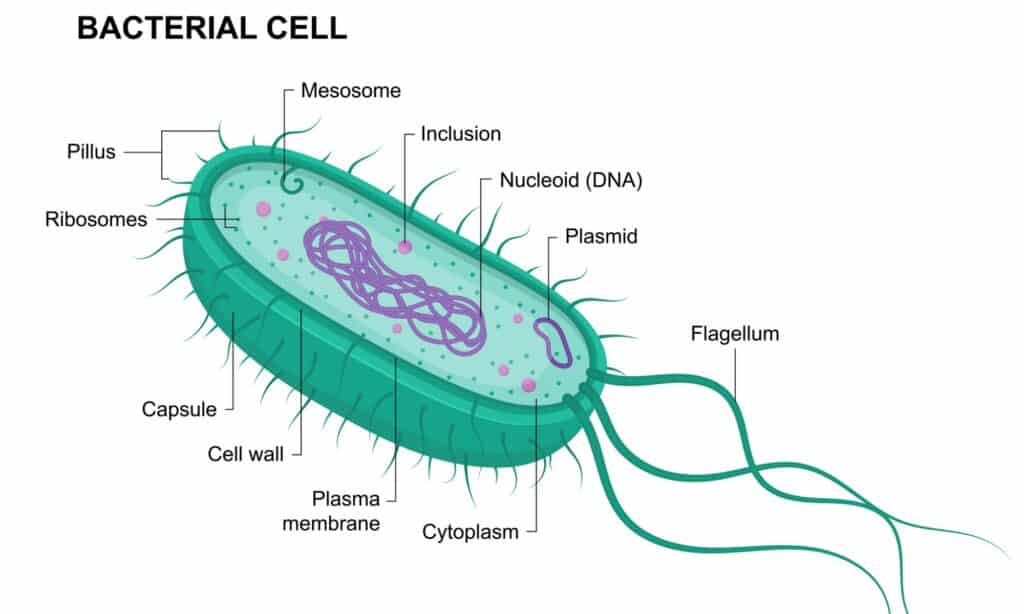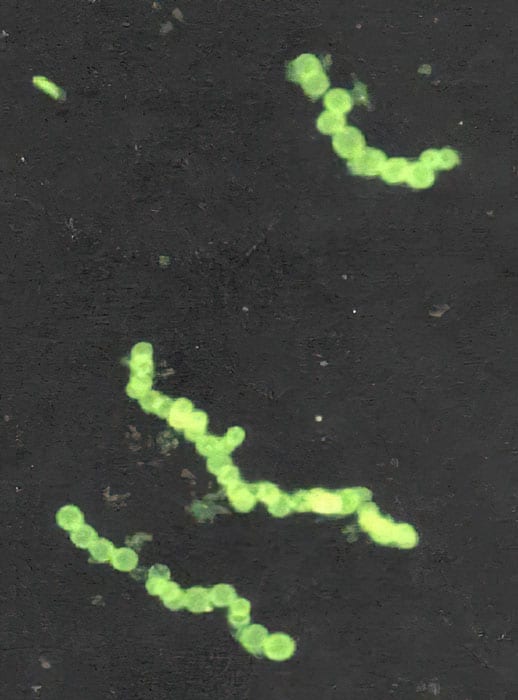The diversity of life forms that exists is absolutely astounding. If we look at size alone, there is a huge range among living things. They can be as massive as the giant blue whale or as small as the tiniest bacteria.
Generally, when we think of bacteria, we think of minuscule, single-celled organisms that are invisible to the naked eye. However, is this always the case? Are there bacteria that are large enough for us to see?
Read on to learn more about the largest bacteria ever recorded!
What Is The Largest Bacterium Ever Recorded?

is the largest bacterium ever recorded; it is 0.9 centimeters long on average and can be up to 2 centimeters long.
©joshimerbin/Shutterstock.com
The largest bacterium ever recorded is Thiomargarita magnifica. A single cell of this bacterium can be an astonishing 0.8 inches (2 centimeters) long. The average length is 0.4 inches (0.9 centimeters). This is longer than the average housefly.
The size of this bacterium defies current scientific theories about limits on the size of bacteria. For a long time, scientists believed that there was a cap on how big a bacterium could be because there was only so much distance that molecules that they exchanged with their surroundings could travel.
If nutrients aren’t able to travel from the membrane to the exterior, and toxins can’t do the opposite, the organism can’t be viable.
This organism circumvents the problem with a water-filled vacuole that makes up approximately 73% of the cell’s volume. This vacuole pushes the other cellular contents up against the cell membrane so that these molecules don’t have that far to travel.
Thiomargarita magnifica is approximately 50 times the size of other giant bacterial species and 5,000 times the size of the average bacteria.
The Largest Bacterium Ever Recorded: Details of Discovery
Thiomargarita magnifica was actually discovered in the early 2010s. Olivier Gros, a marine biologist, observed clusters of white filaments that were growing on decaying leaves in a Caribbean swamp. However, because of their massive size, he understandably didn’t even think they were bacteria, let alone that each filament was actually a single cell.
These organisms are not only humongous in terms of physical size, but they also have very large genomes. These genomes contain approximately 11,000 genes and 11 million bases, which is almost three times what the majority of bacterial genomes contain. However, the genome is very repetitive, with more than half a million copies of some of the sequences.
Additionally, even though most prokaryotes have DNA free floating around the cell, the DNA for this bacterium is held inside a membrane sac. This is a characteristic that is mostly exclusive to eukaryotes. Much more research needs to be done to learn more about this fascinating organism!
The Average Bacterial Cell Size
Most bacterial cells are between one and five micrometers in length. One micrometer is one-thousandth of a millimeter, for perspective. These organisms definitely cannot be seen with the naked eye. In fact, they are even difficult to make out with a light microscope in some cases.
When examining these organisms under a microscope, the objective lens will magnify the image by 100 times, and the ocular lens will magnify it 10 times. The total magnification will be 1,000, enabling scientists to see the bacteria and observe their characteristics.
The small size of these cells makes it so that each cell has a large ratio of surface area to volume. This makes it so that nutrients can enter and waste can exit these cells very quickly.
The Typical Makeup of a Prokaryotic Cell

Prokaryotic cells are typically much smaller and less complex than eukaryotic cells.
©iStock.com/Vitalii Dumma
Bacteria are prokaryotes, as opposed to eukaryotes, which include plants, fungi, and animals. Bacteria are single-celled organisms, although they sometimes cluster together to form larger structures.
The major differences between prokaryotes and eukaryotes have to do with cell structure. Typically, eukaryotic cells contain a nucleus, which is a membrane-bound organelle that contains the DNA of the cell. Eukaryotes also have other membrane-bound organelles, and prokaryotes do not.
Prokaryotic cells are generally also much smaller than eukaryotic cells, with the former being 0.2 to 2 micrometers in diameter, and the latter being 10 to 100 micrometers in diameter.
Several prokaryotes have a capsule, a sticky outermost layer that contains high polysaccharide content. This helps the prokaryotes cluster together and cling to various surfaces. Every prokaryotic cell also has a stiff cell wall, which maintains the shape of the cell and protects the interior. They also have plasma membranes under the cell walls.
Many prokaryotes have appendages that allow the cell to adhere to surfaces or move. When it comes to the DNA they carry, the majority of prokaryotes have one chromosome (one copy of their genetic material), as opposed to eukaryotes, who generally have many chromosomes and two copies of their genetic material.
Prokaryotes also generally do not have a membrane-bound nucleus that holds their genetic material (of course, Thiomargarita magnifica is an exception!). The chromosome is in a section of the cell known as the nucleoid. Several prokaryotes have plasmids in addition to the chromosome; these are small rings of double-stranded DNA. Generally, these are non-essential genes that the cell can transfer to other prokaryotes.
The Previous Record Holder

is about 0.75 millimeters in diameter.
©NASA / public domain – License
The second largest bacterium ever recorded is Thiomargarita namibiensis, which is in the same genus as Thiomargarita magnifica. Until the latter bacterium broke its record, scientists believed this was the largest bacterium in existence.
Thiomargarita namibiensis is a prokaryotic bacterium with a spherical shape that is about 0.75 millimeters in diameter. You can see this bacterium with the naked eye as well. Generally, these bacteria make themselves even more visible by aggregating in chains of at least 10.
Also, Thiomargarita namibiensis shines almost as a pearl does. Scientists also know that it consumes sulfur, and they found it in a location off the coast of Namibia. All of these traits have contributed to its nickname: “Sulfur Pearl of Namibia.”
The reason this bacterium is so large is the huge vacuole inside of it, taking up approximately 98% of the cell. The remainder of the cell consists of cytoplasm and sulfur globules. The purpose of the vacuole is to store the nitrate that the bacterium needs for survival.
The bacterium itself is immobile, so it needs to just stay in one place and wait for whatever nitrate comes into its presence.
The photo featured at the top of this post is © joshimerbin/Shutterstock.com
Thank you for reading! Have some feedback for us? Contact the AZ Animals editorial team.






